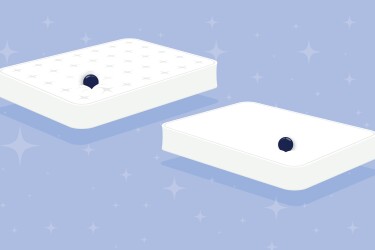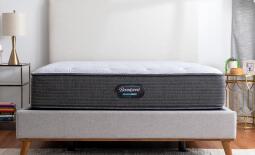Shopping for a new mattress comes with plenty of options. The perfect mattress provides the ideal combination of support and comfort, but what each person finds the most comfortable varies depending on our preferences and sleep styles. While some sleepers feel best on a plush mattress that feels like a fluffy cloud, others wake up feeling great after sleeping on a firm mattress.
Mattress Firm Sleep Expert® Doug Simmons has matched sleepers with the right mattress firmness level for years. He explains that finding the perfect firmness in a new mattress can feel daunting, but testing different firmness scales to get a sense of what feels best to you is simple. Even if you think you know which firmness you’d like when mattress shopping, it’s wise to go into the process with an open mind. The plush-versus-firm topic has some myths to be aware of, he says.
Here’s everything to know about firm versus plush mattresses and how to decide which one will lead to a good night’s sleep.

What Is a Firm Mattress?
When you first lie on a firm mattress, you’ll notice a distinct feeling of being on top of the mattress, with little to no body-conforming material for you to sink into. Unlike memory foam that hugs the body, a firm mattress allows you to float on top of the bed. Because firmer beds tend to have less of a body-contouring feel, some find it easier to change sleeping positions.
Simmons says a firm mattress is one that provides a firm feel on the upper layers. He explains an important distinction when deciding between a plush vs. firm mattress is that firmness level doesn’t relate to support. “Nowadays, a firmer mattress doesn’t always mean more support,” he says. “You can have a firm mattress with great support, or you can have a plush mattress with great support. You can also have a firm or plush mattress with no support.”
Who Should Sleep on a Firm Mattress?
Simmons recommends looking into buying a firm mattress. A main concern of stomach sleepers is spinal alignment, finding a mattress that keeps the hips in line with the shoulders and knees. If the hips sink below the rest of the body, Simmons says sleepers will get into a hammock-like position, which can create or exacerbate lower back pain.
Hot sleepers could also feel relief on a firm mattress, depending on the materials it’s made with. If you tend to overheat at night, regardless of the support level of your mattress, opt for a cooling mattress paired with breathable sheets.
Pros and Cons of Firm Mattresses
A firm mattress might be the best option for some types of sleepers, including stomach sleepers and those with larger frames.
Pros:
- Helps with spinal alignment in stomach sleepers
- Can offer good support for a heavier person bodies
- Easier to change sleeping positions
- Gives the option to add a mattress topper for a more plush comfort layer
Cons:
- Can cause pressure points in the shoulders and hips, especially for side sleepers
- Lightweight sleepers might be uncomfortable
- Could cause more pain for those with muscle and joint pain aches
What Is a Plush Mattress
A plush mattress has additional comfort layers above the support layers. This means a plush mattress will feel softer. Depending on the makeup of the mattress, you might notice sinkage into the mattress more than on a firm bed and that the top could even conform to the body, creating a hug-like feel. Common materials that make a mattress have a plush feel are memory foam, pillow tops and brands’ proprietary support layers like Tempur-Pedic’s Tempur material.
Keep in mind that a plush mattress refers to the upper comfort layers and feel of the bed. The support of the mattress is on the lower layers, so a plush mattress can offer strong support, Simmons explains.
Who Should Sleep on a Plush Mattress?
“A plush mattress is more conforming to the body, where the body's going to sink into the mattress," Simmons says. The conforming and cushioning nature makes it ideal for side and stomach sleepers. Simmons explains our backs aren’t straight — they have an inward curve between the mid-back and tailbone. “We have that little gap in our lower back that creates a little bit of space. If that gap is not getting filled correctly, then your spine is not properly aligned to be properly supported,” he says.
In addition to some back and side sleepers, lightweight individuals might prefer a plush, soft mattress rather than a firm mattress. Because smaller sleepers put less pressure on a mattress, they tend to experience firmer feels on a sleeping surface than a larger body will. Some kids and teens could prefer a softer mattress for the same reason.
Pros and Cons of Plush Mattresses
A soft bed with a plush mattress can be ideal for some sleepers, including many who sleep on their side or back.
Pros:
- Great pressure relief for side sleepers in the shoulders and hips
- Excels in motion isolation
- Provides a conforming feel
- Good spinal support for back sleepers
Cons:
- Stomach sleepers could find their hips dip too far into the mattress
- Additional comfort layers could trap body heat depending on mattress materials
- More difficult to change sleeping positions
- Might cause spinal alignment issues for some sleepers
How To Choose Between a Firm or Plush Mattress
How firm or plush we experience a mattress depends on our preferred sleeping position as well as our body weight and type. Simmons helps out with some things to keep in mind while selecting your ideal type of mattress.
Your Sleeping Position
One of the largest factors in deciding if you need a firm vs. plush mattress is your preferred sleeping position. Stomach sleepers tend to feel best on a firmer bed, while side sleepers need plush pressure relief. Back sleepers and combination sleepers could be suited for either or prefer a mattress with a medium feel.
Your Body Weight and Type
When it comes to deciding between a plush or firm mattress, your body weight and type are important considerations to determine which will be the most comfortable.
Lighter bodies tend to experience a mattress as feeling firmer than heavier bodies. Smaller individuals put less pressure on the layers of a mattress, so it’s possible they’ll prefer a medium-firm mattress or plush mattress.
Sleepers with a larger frame could prefer a firm mattress that keeps the spine in ideal alignment. However, side sleepers of all body types might like a mattress with a plush feel for pressure relief. These sleepers can benefit from a mattress with strong and durable support coils below.
Personal Preferences
Like shopping for new clothes, much of the decision is based on personal preferences. When it comes to mattress firmness, there’s no right or wrong answer, but rather, which feels best for your sleeping preferences.
Shopping at a Mattress Firm gives you the opportunity to test out mattresses that are plush, firm and medium before you buy. Talking with a Sleep Expert® can help ensure you’re finding the best match.

Frequently Asked Questions
Is a Firm Mattress Better for Back Pain?
No. “That is a false statement,” says Simmons. “We want the best support if you have back pain.” He explains that people who suffer from back pain often need a plush mattress with great support in order to get relief. Side sleepers with back pain could make matters worse while sleeping on a mattress that’s too firm.
If you deal with back pain, rather than searching for a firm bed, look for a mattress that excels in supporting spinal alignment while also ensuring the upper comfort layers allow your muscles to fully relax into the mattress.
Is a Plush Mattress Better for Side Sleepers?
If you’re a side sleeper, a plush upper layer could be the most comfortable. Simmons says side sleepers need a plush surface to help with pressure relief in the shoulder and hip areas of the body that can often feel squished while sleeping on your side. A mattress that’s too firm for a side sleeper could cause shoulder or hip pain.
Can I Exchange My Mattress if I Choose the Wrong Firmness Level?
Absolutely. Mattress Firm is home to the Love Your Mattress Guarantee®. You can try out your new mattress at home for 120 nights. If you feel like your mattress is too firm or too soft, you can return your mattress or head into a store for a Sleep Expert® to help find a better mattress for your preferences.
Is It Possible to Have a Mattress That Is Both Firm and Plush?
Yes, it’s totally possible to have a mattress that feels plush when you lay down but offers firm support in the core of the mattress. Simmons mentions these type of mattress feels are especially good for couples who can’t agree on the firmness of the mattress or for couples with different sleeping positions.
Is a Firm Mattress Good for Everyone?
Not necessarily! A firm mattress, as Simmons explains, can be excellent for stomach sleepers who need a firmer surface to ensure ideal spinal alignment. If a mattress doesn’t offer enough support, stomach sleepers can end up in a hammock position, Simmons says, where the hips dip below the shoulders. The result of this hammock could be lower back pain. In this case, a firm mattress could be the best option. Your personal sleep style, preference and body type all determine if a firm mattress would be best for you.







